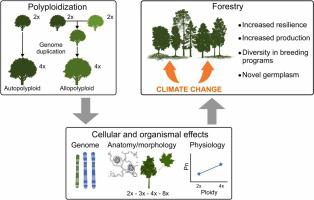当前位置:
X-MOL 学术
›
Forest Ecol. Manag.
›
论文详情
Our official English website, www.x-mol.net, welcomes your feedback! (Note: you will need to create a separate account there.)
Polyploidy – A tool in adapting trees to future climate changes? A review of polyploidy in trees
Forest Ecology and Management ( IF 3.7 ) Pub Date : 2024-03-15 , DOI: 10.1016/j.foreco.2024.121767 Anders Ræbild , Kesara Anamthawat-Jónsson , Ulrika Egertsdotter , Juha Immanen , Anna Monrad Jensen , Athina Koutouleas , Helle Jakobe Martens , Kaisa Nieminen , Jill Katharina Olofsson , Anna-Catharina Röper , Jarkko Salojärvi , Martina Strömvik , Mohammad Vatanparast , Adam Vivian-Smith
Forest Ecology and Management ( IF 3.7 ) Pub Date : 2024-03-15 , DOI: 10.1016/j.foreco.2024.121767 Anders Ræbild , Kesara Anamthawat-Jónsson , Ulrika Egertsdotter , Juha Immanen , Anna Monrad Jensen , Athina Koutouleas , Helle Jakobe Martens , Kaisa Nieminen , Jill Katharina Olofsson , Anna-Catharina Röper , Jarkko Salojärvi , Martina Strömvik , Mohammad Vatanparast , Adam Vivian-Smith

|
Polyploidy, or genome doubling, has occurred repeatedly through plant evolution. While polyploid plants are used extensively in agriculture and horticulture, they have so far found limited use in forestry. Here we review the potentials of polyploid trees under climate change, and investigate if there is support for increased use. We find that polyploid trees like other plants have consistent increases in cell sizes compared to diploids, and that leaf-area based rates of photosynthesis tend to increase with increasing levels of ploidy. While no particular trend could be discerned in terms of biomass between trees of different ploidy levels, physiology is affected by polyploidization and several studies point towards a high potential for polyploid trees to adapt to drought stress. The ploidy level of most tree species is unknown, and analysis of geographical patterns in frequencies of polyploid trees are inconclusive. Artificial polyploid trees are often created by colchicine and in a few cases these have been successfully applied in forestry, but the effects of induced polyploidization in many economically important tree species remains untested. Polyploids would also be increasingly useful in tree breeding programs, to create synthetic hybrids or sterile triploids that could control unwanted spreading of germplasm in nature. In conclusion, this review suggests that polyploid trees may be superior under climate change in some cases, but that the potential of polyploids is not yet fully known and should be evaluated on a case-to-case basis for different tree species.
中文翻译:

多倍体——使树木适应未来气候变化的工具?树木多倍体的综述
多倍体,或基因组加倍,在植物进化过程中反复发生。虽然多倍体植物广泛用于农业和园艺,但迄今为止它们在林业中的用途有限。在这里,我们回顾了气候变化下多倍体树的潜力,并调查是否有支持增加使用。我们发现,与二倍体相比,与其他植物一样,多倍体树的细胞大小持续增加,并且基于叶面积的光合作用速率往往随着倍性水平的增加而增加。虽然不同倍性水平的树木之间的生物量没有明显的趋势,但生理学受到多倍化的影响,一些研究表明多倍体树木具有适应干旱胁迫的巨大潜力。大多数树种的倍性水平是未知的,对多倍体树频率的地理模式的分析尚无定论。人工多倍体树通常是由秋水仙碱产生的,在少数情况下,这些树已成功应用于林业,但诱导多倍体化对许多重要经济树种的影响尚未经过测试。多倍体在树木育种计划中也将越来越有用,以创建合成杂交种或不育三倍体,从而控制自然界种质的不必要传播。总之,本综述表明,在某些情况下,多倍体树木在气候变化下可能更优越,但多倍体的潜力尚未完全了解,应根据不同树种的具体情况进行评估。
更新日期:2024-03-15
中文翻译:

多倍体——使树木适应未来气候变化的工具?树木多倍体的综述
多倍体,或基因组加倍,在植物进化过程中反复发生。虽然多倍体植物广泛用于农业和园艺,但迄今为止它们在林业中的用途有限。在这里,我们回顾了气候变化下多倍体树的潜力,并调查是否有支持增加使用。我们发现,与二倍体相比,与其他植物一样,多倍体树的细胞大小持续增加,并且基于叶面积的光合作用速率往往随着倍性水平的增加而增加。虽然不同倍性水平的树木之间的生物量没有明显的趋势,但生理学受到多倍化的影响,一些研究表明多倍体树木具有适应干旱胁迫的巨大潜力。大多数树种的倍性水平是未知的,对多倍体树频率的地理模式的分析尚无定论。人工多倍体树通常是由秋水仙碱产生的,在少数情况下,这些树已成功应用于林业,但诱导多倍体化对许多重要经济树种的影响尚未经过测试。多倍体在树木育种计划中也将越来越有用,以创建合成杂交种或不育三倍体,从而控制自然界种质的不必要传播。总之,本综述表明,在某些情况下,多倍体树木在气候变化下可能更优越,但多倍体的潜力尚未完全了解,应根据不同树种的具体情况进行评估。



























 京公网安备 11010802027423号
京公网安备 11010802027423号